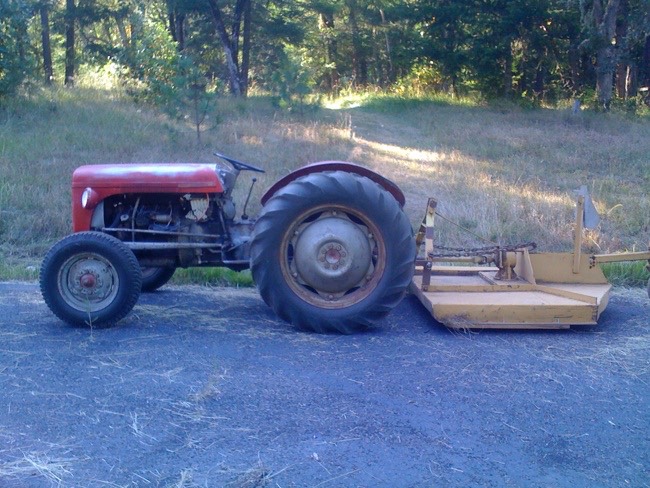This is one of my most useful game design tools:

It’s a tractor equipped with a brush hog (the yellow thing behind the tractor). A brush hog is to a lawnmower what a tank is to a Volkswagen. It does the same basic job of cutting stuff, but it cuts much bigger stuff. It’s meant to be used against brush: dense, thick, heavy brush, brush so tough that the tractor has to fight to get through it. It’s blades cover a span five feet wide. They’re made of 1/2” steel and are quite heavy. They are not sharp at all; sharpening them would be a waste of time, because they smash through rock, dirt, almost anything. They spin very fast, so wherever the brush hog goes, it leaves a trail of destruction behind it. It really does smash rock (although that’s not a good thing, because it does ding the blades a little).
I use the brush hog for clearing brush, of course, but I’ve already finished off most of the thick stuff that I want out. Nowadays I use it mostly for fire protection work: clearing out high grass in strategically selected bands that are meant to act as firebreaks. I also use it against yellow star thistle. This is a nasty weed that came to Oregon (uninvited) from California. Left to itself, it will take over a field and drive out everything else. This has happened to several of my neighbors. There’s only one way to stop it: genocide. You must eliminate it completely from an area or it will just keep coming back, year after year. Actually, it’s even worse: its seeds are viable in the soil for ten years, so for ten years after you kill the last one, you’ll still be having more coming up, which must be taken out before they drop seeds.
I’ve been fighting yellow star thistle on my land for nearly ten years now, but I never had the time to really obliterate it. I’ve been slowly bringing down the population. My best weapon is the brush hog. If you mow the stuff at precisely the right time (the window is less than a week long), you can get it before it can set seeds but late enough in the season that it won’t have time enough to start fresh with a new crop. Since mowing it all can take a week, I seldom get a perfect job done, but I can knock out enough of it that next year, there’s less. For ten years I’ve been driving down the population this way.
As always, the main question people end up asking is, “What does any of this have to do with game design?” Well, now I can answer that question. Last night, I ran into a nasty design problem: how do I count bodies in the game for sources of mortality that apply in both the northern and the southern communities? For example, automobile accidents kill people in Dayton, Ohio, and they also kill people in Delhi, India. So how do I allocate those bodies? Do they count against your northern score or your southern score? I tried to figure out some organized method for allocating them, but there didn’t seem to be any good algorithm.
Too many game designers try to bash through their design problems. They want an answer immediately, and usually the answer they get is wrong. I have developed a strong sense for knowing when it’s time to back off and let my neurons chew over the problem. So this morning I fired up the tractor and set off to wipe out some yellow star thistle. For an hour I worked in the meadow (it’s a BIG meadow), taking out long strips of weeds. The yellow star thistle really is showing the results of my depredations; there were only a few concentrations of the weed. Most of the stuff was isolated plants popping up at random locations around the meadow. These are late seeds from a plant that laid down its seeds years ago. Concentrations represent places where I missed a plant last year, and it laid down a scatter of seeds. As I worked, I turned the problem over in my mind, but most of my mind was on the tractor. If you’ve never driven a tractor across open ground, you’ll know that it’s a rough ride and the front wheels bounce around every which way, requiring concentrated effort just to keep the thing going in a straight line.
This is precisely the kind of thing my mind needs to free up neurons for subconscious design work. After about an hour of work, the solution popped into my head: allocate percentages of bodies based on statistics from the World Health Organization. I can get statistics for each of my different categories, so I don’t need to use some overarching algorithm. The resulting solution is clean and simple to implement.
So I drove back to the shop, parked the tractor, went inside, and went to work. Within an hour I had dug up the statistics I needed, rewritten the relevant equations, calculated the new coefficients, entered everything, and ran it. It worked perfectly – revealing the next problem, which I shall have to work on tomorrow. Then I went out to refill the gas tank on the tractor and noticed a leak in the radiator hose. Replacing the radiator hose on a 60 year old tractor is no mean task, but I got it all taken care by the afternoon.
